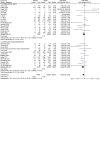Risk of infection and transmission of SARS-CoV-2 among children and adolescents in households, communities and educational settings: A systematic review and meta-analysis
- PMID: 34326997
- PMCID: PMC8285769
- DOI: 10.7189/jogh.11.05013
Risk of infection and transmission of SARS-CoV-2 among children and adolescents in households, communities and educational settings: A systematic review and meta-analysis
Abstract
Background: There is uncertainty with respect to SARS-CoV-2 transmission in children (0-19 years) with controversy on effectiveness of school-closures in controlling the pandemic. It is of equal importance to evaluate the risk of transmission in children who are often asymptomatic or mildly symptomatic carriers that may incidentally transmit SARS-CoV-2 in different settings. We conducted this review to assess transmission and risks for SARS-CoV-2 in children (by age-groups or grades) in community and educational-settings compared to adults.
Methods: Data for the review were retrieved from PubMed, EMBASE, Cochrane Library, WHO COVID-19 Database, China National Knowledge Infrastructure (CNKI) Database, WanFang Database, Latin American and Caribbean Health Sciences Literature (LILACS), Google Scholar, and preprints from medRixv and bioRixv) covering a timeline from December 1, 2019 to April 1, 2021. Population-screening, contact-tracing and cohort studies reporting prevalence and transmission of SARS-CoV-2 in children were included. Data were extracted according to PRISMA guidelines. Meta-analyses were performed using Review Manager 5.3.
Results: Ninety studies were included. Compared to adults, children showed comparable national (risk ratio (RR) = 0.87, 95% confidence interval (CI) = 0.71-1.060 and subnational (RR = 0.81, 95% CI = 0.66-1.01) prevalence in population-screening studies, and lower odds of infection in community/household contact-tracing studies (odds ratio (OR) = 0.62, 95% CI = 0.46-0.84). On disaggregation, adolescents observed comparable risk (OR = 1.22, 95% CI = 0.74-2.04) with adults. In educational-settings, children attending daycare/preschools (OR = 0.53, 95% CI = 0.38-0.72) were observed to be at lower-risk when compared to adults, with odds of infection among primary (OR = 0.85, 95% CI = 0.55-1.31) and high-schoolers (OR = 1.30, 95% CI = 0.71-2.38) comparable to adults. Overall, children and adolescents had lower odds of infection in educational-settings compared to community and household clusters.
Conclusions: Children (<10 years) showed lower susceptibility to COVID-19 compared to adults, whereas adolescents in communities and high-schoolers had comparable risk. Risks of infection among children in educational-settings was lower than in communities. Evidence from school-based studies demonstrate it is largely safe for children (<10 years) to be at schools, however older children (10-19 years) might facilitate transmission. Despite this evidence, studies focusing on the effectiveness of mitigation measures in educational settings are urgently needed to support both public health and educational policy-making for school reopening.
Copyright © 2021 by the Journal of Global Health. All rights reserved.
Conflict of interest statement
Conflict of Interest: The authors have completed the ICMJE Unified Competing Interest form (available on request from the corresponding author), and declare no conflict of interest
Figures





References
-
- World Health Organization. WHO Coronavirus Disease (COVID-19) Dashboard Data last updated: 2021. https://covid19.who.int/. Accessed: 5 April 2021.
Publication types
MeSH terms
LinkOut - more resources
Full Text Sources
Medical
Miscellaneous
